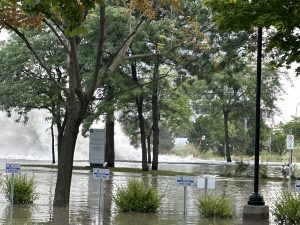How do you make it rain in the desert? Build a mountain. And that’s just what the United Arab Emirates is thinking about doing.
The Emirates is a small nation that lies along the south shore of the Arabian Gulf. Like the surrounding area, it’s desert, where the supply of fresh water is never far from people’s minds.
The government there is considering a way to make it rain and it involves what would be a novel construction project: Build a mountain.
There’s a reason.
Where the topography is right, prevailing winds carry moisture-laden air from the sea onto hills along the shore, forcing the air to rise. As it rises, it cools, losing its ability to hold as much water vapour. So the water vapour condenses and falls as rain.
In a part of Wales, the topography is right. The village of Eglwyswrw, which has hills just inland, has always been rainy. Last winter it had rain for 85 consecutive days, missing the British record by just one day.
Officials in the Emirates took a lesson from Eglwyswrw.
They got in touch with the National Center for Atmospheric Research (NCAR), based in Boulder, Colo., and commissioned a "detailed modelling study" to see if building a mountain in the Emirates might help solve the country’s chronic water shortage.
Roelof Bruintjes is NCAR’s lead researcher on the Emirates project.
Outlining the project he said that his group is "evaluating the effects on weather through the type of mountain, how high it should be and how the slopes should be."
In places like Wales, the effect of the rising damp air is sufficient to cause rain.
In the Emirates, while the air crossing the coast might be damp, it’s not as damp as the air in Wales. That means there is less likelihood of rain. Instead, Bruintjes said, the objective is likely to be the creation of clouds that can then be seeded.
Cloud seeding is a weather modification process that aims to increase the amount of rainfall produced from clouds. It involves using aircraft or rockets to discharge particles of silver iodide into the clouds where they form the nucleus of raindrops.
The idea has been around for years, but results have been uneven. It has been used successfully in parts of the Canadian Prairies, especially southern Alberta.
There has also been some success seeding clouds in Nevada, where operators are just winding down experiments using drones to carry the silver iodide aloft.
In the Emirates, cloud seeding has been used successfully, but on a limited scale. Last year, just $558,000 was spent on the process.
But "building a mountain is not a simple thing," Bruintjes is quoted as saying. His team is still busy examining a variety of factors, like where the mountain should be, how high and how wide. At the same time the team is doing a detailed study of the local climate.
A report from the Food and Agriculture Organization of the United Nations points out that by intercepting the global circulation of air, mountains have a decisive effect on wind, precipitation and temperature patterns. So it’s not quite as simple as cool, moist air rising over a mountain or a coastal ridge.
In the end, says Bruintjes, if the project is too expensive, it likely won’t proceed. But his study will show Emirate officials "what kind of alternatives there are for the long-term future."
The report on the first phase of the project will be complete this summer. If the results of that first study are encouraging, Bruntjes says, "the second phase would be to go to an engineering company and decide whether it is possible or not."
The very idea of building a mountain sounds audacious. But it is one example of the very different kinds of projects the global construction industry will be asked to build in a warming world.
Korky Koroluk is an Ottawa-based freelance writer. Send comments to editor@journalofcommerce.com.











Recent Comments
comments for this post are closed